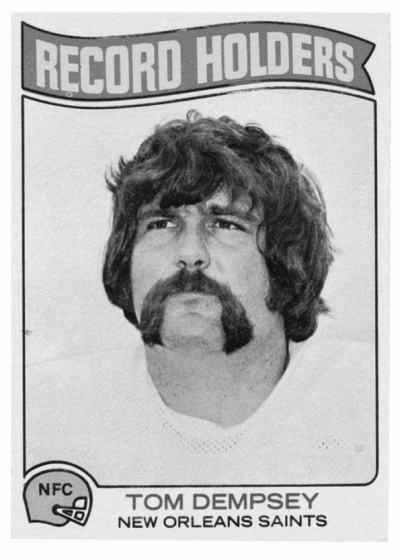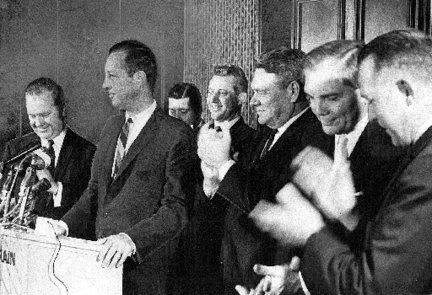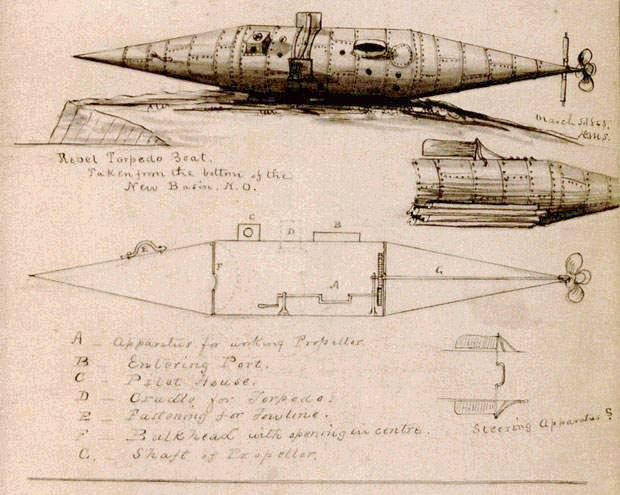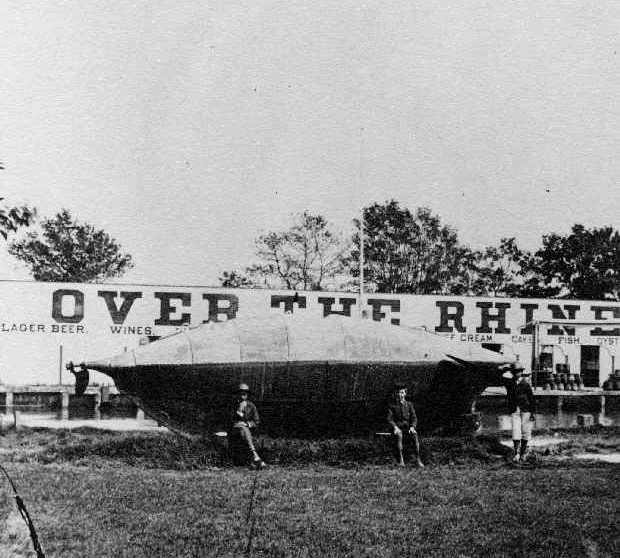|
November 8


Born in New Orleans on November 8, 1876, Arthur Joseph O’Keefe, Sr., was the 48th
mayor of New Orleans. A graduate of St. Aloysius High School, he operated his own coffee import company.
Before becoming mayor, O’Keefe was a prominent member of the Regular Democratic Organization, the political
machine that had dominated New Orleans for decades. He served as the RDO's Tenth Ward boss, the city’s Commissioner
for Public Finance from 1925 to 1926, and after long-time mayor Martin Behrman died in office O’Keefe
was elevated to serve the remainder of Behrman’s term. O’Keefe’s term in office (1926 through 1929) was
marked by a controversy over whether two bridges over the Rigolets and Chef Menteur Pass would be
toll-free bridges as advocated by Public Service Commissioner Huey Pierce Long, Jr., or toll bridges operated
by a firm controlled by the mayor's political allies. O’Keefe also fought a bitter battle with Huey Long over piping
cheap natural gas into New Orleans; an ally of the New Orleans energy monopoly NOPSI, O'Keefe unsuccessfully opposed the
plan. Under O'Keefe's administration construction was begun on the Municipal Auditorium and plans for the Criminal District
Court Building and Orleans Parish Prison were drawn up. He also served as president of the RDO's Choctaw Club. In July
1929, O’Keefe resigned as mayor for health reasons; he was succeeded by T. Semmes Walmsley. He was
also vice-president of the American Bank and Trust Company and director of the Lafayette Fire Insurance Company and the
Mutual Building and Loan Association. O'Keefe died on November 14, 1943.
Nov. 8, 2009 - With their 30-20 win over Carolina, the 8-0 Saints now had the best start in franchise history
James Carroll Booker III (December 17, 1939 – November 8, 1983) was a New Orleans
rhythm and bluesmusician born in New Orleans. Booker's unique style combined rhythm and blues
with jazz standards. Musician Dr. John described Booker as “the best black, gay, one-eyed junkie piano genius New Orleans
has ever produced.
Joseph Francis Rummel, born on October 14, 1876 in Steinmauern, Baden,
was bishop of the Diocese of Omaha, Nebraska (Mar. 30, 1928 - Mar. 9, 1935) and Archbishop
of the Archdiocese of New Orleans (Mar. 9, 1935 - Nov. 8, 1964). By October 1962, Rummel
was eighty-six years old, in declining health, and almost completely blind from glaucoma. Nevertheless, he left
New Orleans for Vatican City to attend the first session of the Second Vatican Council. Archbishop
Joseph Rummel died in New Orleans on November 9, 1964, at the age of eighty-eight. He was succeeded by John
Cody, the Coadjutor Archbishop (1961–1964). Archbishop Rummel is interred under the sanctuary at Saint
Louis Cathedral in the French Quarter. Archbishop Rummel was the Archbishop of New Orleans for twenty-nine
years, through a world war, and the beginning of the Civil Rights era. His Youth Progress Program had a profound impact
on education in the city of New Orleans. and his leadership ended racial segregation in the churches and the schools of
the Archdiocese.Archbishop Rummel High School in Metairie is named after him.
CODY, John Patrick, clergyman, prelate. Born, St. Louis, Mo.,
December 24, 1907; son of Thomas Cody and Mary Begley. Education: Holy Rosary Elementary School, St. Louis;
St. Louis Preparatory Seminary; Propaganda Fide University in Rome, 1926-1930, Ph. D., 1928 and S.T.D., 1930; attended
Appollinaris College in Rome, J.C.D., 1938. Ordained to priesthood in Rome, December 8, 1931; served on
staff of North American College in Rome and at Vatican Secretariate of State, 1932-1938; secretary to John Cardinal Glennon
and later chancellor of Archdiocese of St. Louis, 1938-1947; consecrated titular bishop of Apollonia, July 2, 1947; auxiliary
bishop of St. Louis, 1947-1954; co-adjutor bishop of St. Joseph, Mo., 1954-1956; bishop of Kansas City-St. Joseph, 1956-1961;
appointed titular archbishop of Bostra and co-adjutor to Archbishop Joseph Rummel (q.v.) of New Orleans, July 20,
1961; named apostolic administrator of New Orleans, June 1, 1962; became archbishop of New Orleans,
November 8, 1964. Major contributions to New Orleans archdiocese include: establishment of twenty-five
new parishes; vast building program of churches and schools; vigorous program of social justice highlighted by integration
of Catholic schools; initiation of new programs for youth, handicapped, needy, and Catholic students in state colleges and
universities; re-organization of the archdiocesan administration and finances; promotion of greater lay participation in
church through Confraternity of Christian Doctrine and Family Life Bureau; encouragement of closer relationship with Protestant
and Jewish communities through Operation Understanding. Appointed archbishop of Chicago, June 16, 1965; named cardinal
priest, June 26, 1967 (first New Orleans prelate or former prelate to be named to College of Cardinals).
Died, Chicago, April 25, 1982; interred Mt. Carmel Cemetery, Hillside, Ill. From http://lahistory.org/site20.php
November 8, 1892 -- The New Orleans general strike begins, uniting black and white American trade
unionists in a successful four-day general strike action for the first time.
The Kick Heard 'Round the World
Saint Tom Dempsey Breaks
Record
November 8, 1970 Any New Orleanian who heard
the radio broadcast of the Detroit Lions vs the Saints game on November 8, 1970 still remembers the kick. One local
sage wrote that many more people claimed to have been there that day than could possibly have fit into Tulane Stadium.
Many fans who had actually gone to the game left early, thinking that the Saints could not possibly catch up the Lions.
But in the final seconds, Tom Dempsey set a still-unbroken NFL-record 63 yard field goal to give the New Orleans Saints a
19-17 victory over the Detroit Lions at our home field. With two seconds
left in the game, with the Saints behind with a score of 17-16, Thomas John Dempsey broke the record and became the major
player (Joe Scarpati held the ball) in one of the most cherished memories in Saints history. His feat came to be known as
“The kick heard around the world”. He had beat the record of 56 yards set by Bert Rechichar two decades before.
As of 2013, the record has been matched but never broken. Born without a right
hand and only half a right foot, he wore a custom-made shoe which caused some controversy as to whether it afforded him an
advantage over other kickers. In 1977 the “Tom Dempsey Rule” was adopted by the NFL which mandates that "any
shoe that is worn by a player with an artificial limb on his kicking leg must have a kicking surface that conforms to that
of a normal kicking shoe." As a Saint he played in
the Pro Bowl in 1969 – his first year as a professional. It was in his second season that blasted the “kick heard
‘round the world”. He went on the play with Philadelphia, Los Angeles, Houston, and Buffalo before retiring in
1979 with an eleven year career. And then he went back to his adopted home in Metairie to raise his family. Tom Dempsey was inducted into the New Orleans Saints Hall of Fame in 1989 and the American
Football Kicking Hall of Fame in 2010. From
Legendary Locals of Metairie by Catherine Campanella
Louisiana Voters Approve Amendment 10 to Build a Domed Stadium
November 8, 1966
On November 1, 1966 the National Football League
awarded its 16th franchise to New Orleans. NFL Commissioner Pete Rozelle made the announcement at the now defunct Pontchartrain
Hotel on St. Charles Avenue. The New Orleans States-Item afternoon newspaper produced a "RED FLASH" issue with the
headline "N.O. GOES PRO!" stretched across its first page. The Times-Picayune simply included
a small one column article titled "N.O. To Be Given NFL Franchise". This article was small compared with larger
titles "Viet Cong Shell Heart of Saigon" and "City Levy on Income [Tax] Unlikely, Says [City Council President]
Petrie" -- both articles were alloted vastly more homepage area. But most New Orleanians and many Louisianians were thrilled
on that All-Saints Day to see (and hear) the news. At the press conference, which
was held shortly after 12 noon, Commissioner Rozelle briefly told the story of events leading to the decision to award the
franchise to New Orleans. He said that during the preceding month of May, Governor John McKeithen, Mayor Victor Schiro,
U.S. Senator Russell B. Long (Democratic Senate Majority Whip),
and U.S. Congressman Hale Boggs (Democratic Congressional Majority Whip) had gone to Washington
and "That peaked our interest and got all our people thinking a little more about New Orleans". What he did
not say (but implied to those informed) was that their intent was to support and encourage the passage of a law proposed in
the 89th United States Congress, which would exempt a proposed merger of the NFL with the AFL from antitrust law sanctions.
That law, titled the Senate; Hearings of Subcommittee on Antitrust
and Monopoly (S.Con.Res. 109 of the 89th U.S. Congress) was signed by President Johnson on October 19, 1966
(just 13 days before the awarding of the New Orleans franchise). Boggs and Long were
instrumental in its passage which allowed the two leagues to combine to form an expanded league with additional teams.
The first of those new teams was the Saints. "There is no question", said Rozelle at the press conference on November
1, "that their leadership [Boggs and Long] in Washington was tremendously significant". The photo was taken at the press conference on November 1, 1966. Photographer: J. W. Guillot
/ The Times-Picayune. Russell Long is on the left. Pete Rozelle is at the podium. From right to left are
Dave Dixon, John McKeithen, and Hale Boggs. Dave Dixon was praised
by Rozelle for his contributions..."I guess it started five years ago when David Dixon started hounding our league meetings.
He's been pushing it for five years and I think that the great civic interest he has shown should certainly be recognized
here today". The following day ( November 2, 1966), Times-Picayune Sports Editor Bob Roesler wrote that
Dixon had contacted NFL Commissioner Bert Beli and AFL team owners, as early as 1957, regarding a professional team in New
Orleans and had worked since then to see this happen. Dixon was quoted as saying, "I could write 10 books"
about experiences along the way. He did, in fact write one, with the publication of The Saints, the Superdome, and the Scandal which was published on February 15, 2008. Rozelle
also credited John F. Tims, president and publisher of the the Times-Picayune Publishing Company whose support "was another
factor in encouraging us to come here". He praised the support of Tulane officials in regard to the use of the
82,000 seat Sugar Bowl Stadium -- another significant factor in the league's decision to choose New Orleans over six other
cities (Seattle, Cincinnati, Boston, Houston, Phoenix and Portland) vying for the franchise. Of those, he said,
Seattle, Cincinnati, and New Orleans were still in contention as of the week before when NFL and AFL officials visited all
three. When the vote was taken by the 24 team owners, New Orleans was unanimously chosen. Commissioner Rozelle added that New Orleans had the population, the sports interest, the weather, and
the geological location which would ensure the success of a professional team and added that New Orleans was under
consideration for the upcoming January Superbowl. Regarding the team playing at Tulane, Rozelle said it had "an
excellent stadium" but that "a new stadium is a necessity". Councilman Maurice "Moon" Landrieu
represented Mayor Schiro at the press conference, who had other commitments that day. Schiro issued a press release
stating "This will not be just New Orleans' or Jefferson Parish's team. I predict that the Louisiana fans
will be the most fervant in the National League".
No owner for the new team had yet been chosen but three had publicly expressed interest; Louis S. Rousell,
Jack Sanders, and John Mecom Jr. New Orleans businessman and civic activist Edgar Stern had reportedly gathered a group
of local businessmen who were interested in ownership which was unofficially estimated to be $8.5 million payable over five
years. Rozelle said that the team would spit television revenue with the NFL. Finally, Rozelle said that another
team franchise would be added next year in the AFL. In Times-Picayune
Sports Editor Bob Roesler's November 2, 1966 column, he quoted Dave Dixon as saying, "I stumped
the state the past two months for Constitutional Amendment No. 10" which, if passed by the voters, would fund an all-purpose
domed facility in the Greater New Orleans area. Dixen felt that most Louisianians were in favor of it. Also in
his column that day, Roesler wrote, "The New Orleans Saints, or whatever they'll be called, would participate
in the mid-January draft". This was likely the first time the team had ever been referred to as "The Saints"
in the print media On November 8, 1966 (one
week after the franchise was granted), voters approved the Amendment 10. On December 15, John W. Mecom,
Jr. became the majority stockholder-president of franchise. On December 22, Victor E. Schwenk was
appointed director of player personnel, on December 27, Tom Fears was named the head coach. It wasn't
until January 9, 1967 that the team was officially named "Saints".
Submarine Creator Horace L. Hunley is Buried with Full Military Honors November 8, 1863 The Confederate submarine Pioneer drawn by Ensign David M.
Stauffer of the Mississippi Squadron, 1865. New Orleans,
surrounded by water, which has been our source of pleasure and pain, played a major part in the development of military submarines.
At the beginning of the Civil War, President Abraham Lincoln ordered a blockade of all Southern ports. To augment his
own Navy, Confederate President Jefferson Davis issued a proclamation inviting applications for letters of marque to encourage
reprisal against Federal ships and property. Respondents were drawn to the Algiers dockyards and to vessels suitable for
refitting as privateers.
Across the river at Leeds foundry, steam gauge manufacturers James McClintock
and Baxter Watson constructed a submarine to use against Union gunboats patrolling Lake Pontchartrain. They would eventually
partner with Horace L. Hunley, a wealthy lawyer and customs agent, to build a submarine with a menacing, streamlined appearance.
After the war, McClintock described the vessel he and his partners christened the Pioneer. - "…she was made of iron ¼ inch thick. The boat was of a cigar shape 30 feet
long and 4 feet in diameter. This boat demonstrated to us that we could construct a boat that would move at will in any
direction desired, and at any distance from the surface. As we were unable to see objects passing under the water, the
boat was steered by compass…"
In March of 1862, the Pioneer's owners were granted a letter of
marque by the Confederate government. A month later, New Orleans fell to the West Gulf Blockading Squadron commanded by
David Glasgow Farragut. In the ensuing turmoil, the Pioneer was scuttled [deliberately sunk] in the New Basin Canal.
The ship was quickly discovered in its watery grave and brought to shore. A Federal team of experts was dispatched to examine
the "infernal machine" and later submitted their measured drawings to Fleet Engineer William Shock, who completed
and forwarded them to Washington, D.C. for further study.|
The Bayou St. John submarine at Spanish Fort amusement park, 1895 photograph by George F.
Mugnier And yet another Civil War submarine was built here, this one on the banks of Bayou St.
John. Its history can be traced to 1878 when it was removed from Lake Pontchartrain and placed on the levee by a dredge
crew working near the mouth of Bayou St. John. For years after its recovery, the boat lay neglected on the lakeshore.
By 1895, it was placed on display at Spanish Fort where it became a prominent landmark. A period of neglect followed,
during which the submarine was taken from its wooden stand at the Fort and left lying in the weeds. A remaining propeller
blade was removed by vandals and large areas of loss appeared along the lower hull. Later, in 1908, it was moved to the
Camp Nicholls Confederate Home on Bayou St. John. In 1942, it was acquired by the State Museum and moved to Jackson Square.
Some years later the museum transferred it into the lower Pontalba Building, where it was featured in a "Defense
Exhibit." It was eventually moved under the Presbytere arcade in 1957 before being transferred to the conservatory
of the Louisiana State Museum in December of 1999. When restored, it will reside in the Baton Rouge branch with
exhibits on major events in Louisiana history. Interpretive text and displays will illustrate the vessel's place in the
State's maritime and Civil War history. 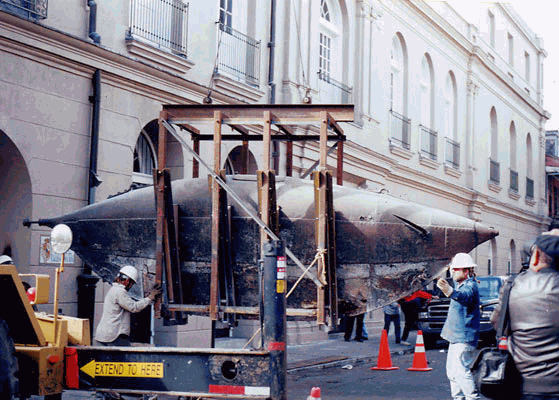 Submarine being transported to transferred to the conservatory of the Louisiana State Museum
in 1999 For decades, the vessel's identity had vexed researchers. Many
thought the submarine was the Pioneer, the first commissioned Confederate submarine that was constructed in New Orleans
by the same group that later built the C.S.S. Hunley - the famed submarine now undergoing conservation at the Warren Lasch
Conservation Center in Charleston, S.C. However, a drawing of the pioneer recently discovered in the National Archives by
naval historian Mark Ragan illustrates that the State Museum's submarine and the Pioneer are not the same vessel.
A key player in the development of these hand-powered submarines was Confederate marine engineer
Horace Lawson Hunley. Born in Sumner County, Tennessee (on June 20, 1823) his parents (Louisa Harden
Lawson and John Hunley) relocated to New Orleans when he was a boy. Hunley served in the Louisiana State Legislature and
practiced law in New Orleans. In 1861, after the start of the war, he joined James R. McClintock and Baxter Watson in
building the Pioneer. The most famous of his boats was posthumously named for him, H. L. Hunley which played a small
part in the American Civil War, but a large role in the history of naval warfare as the first combat submarine to sink an
enemy warship, the USS Housatonic. Five men from the first crew of H. L. Hunley died during early tests when she
was accidentally swamped by the wake of a passing ship through her open hatches; four managed to escape. A second crew was
recruited in Charleston. On October 15, 1863, though he was not part of the crew, Hunley decided to
take command during a routine exercise. The vessel again sank, and this time all eight crew members were killed, including
Hunley himself. The vessel was later raised and used again in the first successful sinking of an enemy vessel (the USS Housatonic
(1861)) by a submarine in naval history, but the submarine soon sank too. Horace L. Hunley was buried with full military
honors at Magnolia Cemetery in Charleston, South Carolina, on November 8, 1863. (Images and most text from
the Louisiana State Museum)
|





